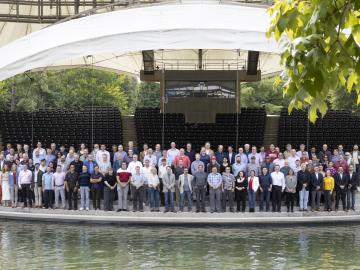
Filter News
Area of Research
- Biology and Environment (30)
- Computational Biology (1)
- Computer Science (2)
- Energy Science (19)
- Fusion and Fission (5)
- Isotopes (16)
- Materials (22)
- Materials for Computing (5)
- National Security (20)
- Neutron Science (9)
- Nuclear Science and Technology (7)
- Quantum information Science (3)
- Supercomputing (60)
News Type
News Topics
- (-) Advanced Reactors (12)
- (-) Composites (11)
- (-) Computer Science (111)
- (-) Cybersecurity (14)
- (-) Exascale Computing (51)
- (-) Hydropower (6)
- (-) Isotopes (33)
- (-) Machine Learning (37)
- (-) Microscopy (23)
- 3-D Printing/Advanced Manufacturing (56)
- Artificial Intelligence (77)
- Big Data (45)
- Bioenergy (68)
- Biology (80)
- Biomedical (42)
- Biotechnology (25)
- Buildings (30)
- Chemical Sciences (35)
- Clean Water (16)
- Coronavirus (19)
- Critical Materials (5)
- Education (2)
- Emergency (3)
- Energy Storage (32)
- Environment (116)
- Fossil Energy (6)
- Frontier (44)
- Fusion (38)
- Grid (32)
- High-Performance Computing (81)
- ITER (4)
- Materials (51)
- Materials Science (55)
- Mathematics (8)
- Mercury (7)
- Microelectronics (3)
- Molten Salt (2)
- Nanotechnology (17)
- National Security (60)
- Neutron Science (82)
- Nuclear Energy (66)
- Partnerships (36)
- Physics (34)
- Polymers (9)
- Quantum Computing (35)
- Quantum Science (48)
- Security (16)
- Simulation (42)
- Software (1)
- Space Exploration (13)
- Statistics (2)
- Summit (40)
- Transportation (30)
Media Contacts

ORNL and NASA co-hosted the fourth iteration of this invitation-only event, which brings together geospatial, computational, data and engineering experts around a theme. This year’s gathering focused on how artificial intelligence foundation models can enable geospatial digital twins.

To bridge the gap between experimental facilities and supercomputers, experts from SLAC National Accelerator Laboratory are teaming up with other DOE national laboratories to build a new data streaming pipeline. The pipeline will allow researchers to send their data to the nation’s leading computing centers for analysis in real time even as their experiments are taking place.

ORNL researchers were honored with a prestigious ACE Award for Composites Excellence by the American Composites Manufacturers Association. The team won the “innovation in green composites design” prize for creating a fully recyclable, lightweight wind turbine blade tip that incorporates low-cost carbon fiber and conductive coating for enhanced protection against lightning strikes.

Prasanna Balprakash, director of AI programs for ORNL, discussed advancing climate and weather research through high performance computing and artificial intelligence as part of a September 18 panel for the United States Senate.

The Smoky Mountain Computational Sciences and Engineering Conference, or SMC24, entered its third decade with the 21st annual gathering in East Tennessee.

The Oak Ridge Leadership Computing Facility welcomed users to an interactive meeting at the Department of Energy’s Oak Ridge National Laboratory from Sept. 10–11 for an opportunity to share achievements from the OLCF’s user programs and highlight requirements for the future.

The Summit supercomputer, once the world’s most powerful, is set to be decommissioned by the end of 2024 to make way for the next-generation supercomputer. Over the summer, crews began dismantling Summit’s Alpine storage system, shredding over 40,000 hard drives with the help of ShredPro Secure, a local East Tennessee business. This partnership not only reduced costs and sped up the process but also established a more efficient and secure method for decommissioning large-scale computing systems in the future.
After retiring from Y-12, Scott Abston joined the Isotope Science and Engineering Directorate to support isotope production and work with his former manager. He now leads a team maintaining critical equipment for medical and space applications. Abston finds fulfillment in mentoring his team and is pleased with his decision to continue working.

As high-tech companies ramp up construction of massive data centers to meet the business boom in artificial intelligence, one component is becoming an increasingly rare commodity: electricity. Since its formation in 2004, the OLCF has fielded five generations of world-class supercomputing systems that have produced a nearly 2,000 times reduction in energy usage per floating point operation per second, or flops. With decades of experience in making HPC more energy efficient, the OLCF may serve as a resource for best “bang for the buck” practices in a suddenly burgeoning industry.

Office of Science to announce a new research and development opportunity led by ORNL to advance technologies and drive new capabilities for future supercomputers. This industry research program worth $23 million, called New Frontiers, will initiate partnerships with multiple companies to accelerate the R&D of critical technologies with renewed emphasis on energy efficiency for the next generation of post-exascale computing in the 2029 and beyond time frame.


